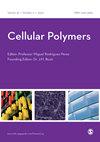明胶基全生物发泡膜的制备与表征
IF 1.3
4区 医学
Q4 MATERIALS SCIENCE, BIOMATERIALS
引用次数: 3
摘要
本研究的目的是生产和表征明胶泡沫薄膜的挤压。通过压延法制备了含有单宁酸、纳米粘土(Cloisite Na+)、甘油、水和明胶的三种“最佳”配方,以及不含单宁酸和纳米粘土的三种“对照”配方。此外,三种“最佳”配方仅通过挤出吹膜生产,因为无法获得稳定的加工条件作为控制。完成了一套完整的样品表征,包括形态,机械,物理和热性能。结果表明,除加工方法外,厚度还受甘油和水分含量的控制,导致密度略高于1,最佳材料的密度值较高。最佳配方的压延膜总体上显示细胞数量和细胞密度高于对照。由于单宁酸和纳米粘土的增强作用,两种方法制备的最佳配方均获得了较高的弹性模量和抗拉强度,但这导致了较低的断裂应变。所有薄膜的热分布相似,最佳配方具有较高的稳定性。通过傅里叶变换红外光谱观察到的组分之间的化学相互作用也解释了这一结果。总的来说,最佳配方不仅在一般性能方面产生更好的泡沫薄膜,而且通过两种方法(压延和吹制)更容易加工。本文章由计算机程序翻译,如有差异,请以英文原文为准。
Production and characterization of fully biobased foamed films based on gelatin
The objective of this study was to produce and characterize gelatin foamed films using extrusion. Three “optimum” formulations containing tannic acid, nanoclays (Cloisite Na+), glycerol, water, and gelatin, as well as three “controls” without tannic acid and nanoclays were prepared by calendering. Furthermore, the three “optimum” formulations were produced by extrusion film blowing only, since no stable processing conditions could be obtained for the controls. A complete set of sample characterization was performed, including morphological, mechanical, physical, and thermal properties. The results showed that besides the processing method, the thickness was also controlled by the glycerol and water content, leading to density slightly above unity, with higher values for the optimum materials. The calendered films from the optimum formulations showed overall a higher number of cells and cell density than the controls. Higher elastic moduli and tensile strengths were obtained for the films from the optimum formulations made by either method because of the reinforcing effect of the tannic acid and nanoclays, but this led to lower strain at break. The thermal profiles were similar for all films, with higher stability for the optimum formulations. The results were also explained via chemical interactions between the components as observed by Fourier transform infrared spectroscopy. Overall, the optimum formulations not only produced better foamed films in terms of general properties but were much easier to process by both methods (calendering and blowing).
求助全文
通过发布文献求助,成功后即可免费获取论文全文。
去求助
来源期刊

Cellular Polymers
工程技术-材料科学:生物材料
CiteScore
3.10
自引率
0.00%
发文量
9
审稿时长
3 months
期刊介绍:
Cellular Polymers is concerned primarily with the science of foamed materials, the technology and state of the art for processing and fabricating, the engineering techniques and principles of the machines used to produce them economically, and their applications in varied and wide ranging uses where they are making an increasingly valuable contribution.
Potential problems for the industry are also covered, including fire performance of materials, CFC-replacement technology, recycling and environmental legislation. Reviews of technical and commercial advances in the manufacturing and application technologies are also included.
Cellular Polymers covers these and other related topics and also pays particular attention to the ways in which the science and technology of cellular polymers is being developed throughout the world.
 求助内容:
求助内容: 应助结果提醒方式:
应助结果提醒方式:


